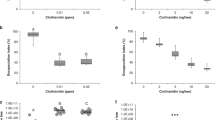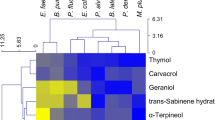Abstract
Specific conditions of the honeybee life honeybee life require the presence of effective mechanisms of antiinfectious protection whose one of the most important components are defensins—the family of antimicrobial peptides. In the honeybee, defensins are present in the form of two different peptides—defensin 1 and 2 that are similar between each other only by 55.8%. Defensin 1 synthesized in salivary glands plays an important role in social immunity, whereas defensin 2 synthesized by cells of fat body and lymph is an important factor in the system of the honeybee individual immunity. Defensins are inducible, are controlled by interaction of Toll and Imd signal pathways and have a large specter of antimicrobial action.
Similar content being viewed by others
References
Casteels, P., Ampe, C., Jacobs, E., and Tempst, P., Functional and Chemical Characterization of Hymenoptaecin, an Antibacterial Polypeptide That Is Infection-Inducible in the Honeybee (Apis mellifera), J. Biol. Chem., 1993, vol. 268, pp. 7044–7054.
Cremer, S., Armitage, S.A., and Schmid-Hempel, P., Social Immunity, Curr. Biol., 2007, vol. 17, no. 16, pp. 693–702.
Hoffmann, J.A., Kafatos, F.C., Janawey, C.A., and Ezekovits, R.A.B., Phylogenetic Perspectives in Innate Immunity, Science, 1999, vol.284, pp. 1313–1318.
Hoffmann, J.A. and Richhart, J.-M., Drosophila Immunity, Trends Cell Biol., 1997, vol. 7, pp. 309–316.
Brey, P.T., Lee, W., Yamakawa, M., Koizumi, Z., Perrot, S., Francois, M., and Ashida, M., Role of the Integument in Insect Immunity: Epicuticular Abrasion and Induction of Cecropin Synthesis in Cuticular Epithelial Cells, Proc. Nat. Acad. Sci. USA, 1993, vol. 90, pp. 6275–6279.
Lehane, M.J., Wu, D., and Lehane, S.M., Midgut-Specific Immune Molecules are Produced by the Blood-Sucking Insect Stomoxys calcitrans, Proc. Nat. Acad. Sci. USA, 1997, vol. 94, pp. 11502–11507.
Lowenberger, C.A., Smartt, C.T., Bulet, P., Ferdig, M.T., Severson, D.W., Hoffman, J.A., and Christensen, B.M., Insect Immunity: Molecular Cloning, Expression, and Characterization of cDNAs and Genomic DNA Encoding Three Isoforms of Insect Defensin in Aedes aegypti, Insect Mol. Biol., 1999, vol. 8, pp. 107–118.
Aerts, A.M., Francois, I.E., Cammue, B.P., and Thevissen, K., The Mode of Antifungal Action of Plant, Insect and Human Defensins, Cell. Mol. Life Sci., 2008, vol. 65, pp. 2069–2079.
Bulet, P., Hetru, C., Dimarcq, J.L., and Hoffmann, D., Antimicrobial Peptides in Insects; Structure and Function, Dev. Comp. Immunol., 1999, vol. 23, pp. 329–344.
Miyagi, T., Peng, Ch.Y.S., Chuang, R.Y., Mussen, E.C., Spivak, M.S., and Doi, R.H., Verification of Oxytetracycline-Resistant American Foulbrood Pathogen Paenibacillus Larvae in the United States, J. Invertebr. Pathol., 2000, vol. 75, pp. 95–96.
Bilikova, K., Gusui, W., and Simuth, J., Isolation of a Peptide Fraction from Honeybee Royal Jelly as a Potential Antifoulbrood Factor, Apidologie, 2001, vol. 32, pp. 275–283.
Chernysh, S.I., Gordya, N.A., and Filatova, N.A., Protective Mechanisms of Insects: the Temps of Molecular and Phenotypic Evolution, Issled. Genet., 1999, Iss. 12, pp. 52–59.
Klaudiny, J., Hanes, J., Kulifajova, J., Albert, S., and Simuth, J., Molecular Cloning of Two cDNAs from the Head of the Nurse Honeybee (Apis mellifera L.) for Coding Related Proteins of Royal Jelly, J. Apic. Res., 1994, vol. 33, pp. 105–111.
Casteels, P., Ampe, C., Jacobs, F., Vaek, M., and Tempst, P., Apidaecins: Antibacterial Peptides from Honeybees, EMBO J., 1989, vol. 8, pp. 2387–2391.
Casteels, P., Ampe, C., Riviere, L., Damme, J.V., Elicone, C., Fleming, M., Jacobs, F., and Tempst, P., Isolation and Characterization of Abae cin, a Major Antibacterial Peptide in the Honeybee (Apis mellifera), Eur. J. Biochem., 1990, vol. 187, pp. 381–386.
Fujiwara, S., Imai, J., Fujiwara, M., Yaeshima, T., Kawashima, T., and Kobayashi, K.A., Potent Antibacterial Protein in Royal Jelly, J. Biol. Chem., 1990, vol. 265, pp. 11 333–11 337.
Klaudiny, J., Albert, S., Bachanova, K., Kopernicky, J., and Simuth, J., Two Structurally Different Defensin Genes, One of them Encoding a Novel Defensin Isoform, are Expressed in Honeybee Apis mellifera, Insect Biochem. Molec. Biol., 2005, vol. 35, pp. 11–22.
Kwakman, P.H.S., te Velde, A.A., de Boer, L., Speijer, D., Vandenbroucke-Grauls, C.M.J.E., and Zaat, S.A.J., How Honey Kills Bacteria, The FASEB J., 2010, vol. 24, no. 7, pp. 2576–2582.
Casteels-Josson, K., Zhang, W., Capaci, T., Casteels, P., and Tempst, P., Acute Transcriptional Response of the Honeybee Peptide-Antibiotics Gene Repertoire and Required Posttranslational Conversion of the Precursor Structures, J. Biol. Chem., 1994, vol. 269, pp. 28569–28575.
Hanzawa, H., Shimada, I., Kuzuhara, T., Komano, H., Kohda, D., Inagaki, F., Natori, S., and Arata, Y., 1H Nuclear Magnetic Resonance Study of the Solution Conformation of an Antibacterial Protein, Sapecin, FEBS Lett., 1990, vol. 269, pp. 413–420.
Raj, P.A. and Dentino, A.R., Current Status of Defensins and Their Role in Innate and Adaptive Immunity, FEMS Microbial. Lett., 2002, vol. 206, pp. 9–18.
Long, M., Evolution of Novel Genes, Curr. Opinion Genet. Dev., 2001, vol. 11, pp. 673–680.
Rees, J.A., Moniatte, M., and Bulet, P., Novel Antibacterial Peptides Isolated from a European Bumblebee, Bombus pacuorum (Hymenoptera, Apoidea), Insect Biochem. Mol. Biol., 1997, vol. 27, pp. 413–422.
Cornet, B., Bonmatin, J.-M., Hetru, C., Hoffmann, J.A., Ptak, M., and Vovelle, F., Refined Three-Dimensional Solution Structure of Insect Defensin A, Structure, 1995, vol. 3, pp. 435–441.
Yoshiyama, M. and Kimura, K., Characterization of Antimicrobial Peptide Genes from Japanese Honeybee Apis cerana japonica (Hymenoptera: Apidae), Appl. Entomol. Zool., 2010, vol. 45, no. 4, pp. 609–614.
Ilyasov, R.A., Poskryakov, A.V., and Nikolenko, A.G., Polymorphism of the Antibacterial Preparations in the population of Ural Honeybees, Bioraznoobrazie: problemy i perspektivy sokhraneniya (Biovariety: Problems and Perspectives of Preservation), Proc. Internat. Scient. Conference, Penza, 2008, vol. 2, pp. 247–248.
Solbrig, O. and Solbrig, D., Populyatsionnaya biologiya i evolutsiya (Populational Biology and Evolution), Mir, Moscow, 1982, 244 pp.
Dimarcq, J.L., Hoffman, D., Meister, M., Bulet, P., Lanot, R., Reichhart, J.M., and Hoffman, J.A., Characterization and Transcriptional Profiles of a Drosophila Gene Encoding an Insect Defensin, Eur. J. Biochem., 1994, vol. 221, pp. 201–209.
Lopez, L., Morales, G., Ursic, R., Wolff, M., and Lowneberger, C., Isolation and Characterization of a Novel Insect Defensin from Rhodnius prolixus, a Vector of Chagas Disease, Insect Biochem. Mol. Biol., 2003, vol. 33, pp. 439–447.
Bulet, P. and Stocklin, R., Insect Antimicrobial Peptides: Structure, Properties and Gene Regulation, Prot. Peptide Lett., 2005, vol. 12, pp. 3–11.
Arbia, K.A. and Babbay, B., Management Strategies of Honeybee diseases, J. Entomol., 2011, vol. 8, no. 1, pp. 1–15.
Bachanova, K., Klaudiny, J., Kopernicky, J., and Simuth, J., Identifcation of Honeybee Peptide Active against Paenibacillus larvae larvae through Bacterial Growth-Inhibition Assay on Polyacrylamide Gel, Apidologie, 2002, vol. 33, pp. 259–269.
Yoon, H.J., Sohn, M.R., Young, M.C., Jianhong, L., Hung, D.S., and Byung, R.J., Defensin Gene Sequences of Three Different Bumblebees, Bombus spp., J. Asia-Pacific Entomol., 2009, vol. 12, pp. 27–31.
Saltykova, E.S., Gaifullina, L.R., Ilyasov, R.A., and Nikolaenko, A.G., Effect of Chitozan on Induction of the Main Honeybee Antibacterial Peptides, Sovremennye perspektivy v issledovanii khitina i khitozana (Current Perspectives in the Study of Chitin and Chitozan), Proc. Tenth Scient. Internat. Confer., Nizhnii Novgorod, 2010, pp. 308–310.
Saltyikova, E.S., Ilyasov, R.A., Gaifullina, L.R., Poskryakov, A.V., Yamidanov, R.S., and Nikolaenko, A.G., Change of the Level of Antibacterial Peptides in the Organism of Honeybee Apis mellifera mellifera L., Sovremennoe pchelovodstvo. Problemy, opyt, novye tekhnologii (Current Apiculture. Problems, Experience, New Technologies), Proc. Internat. Scient. Confer., Yaroslavl, 2010, pp. 159–160.
Aronstein, K.A., Murray, K.D., and Saldivar, E., Transcriptional Responses in Honeybee Larvae Infected with Chalkbrood Fungus, BMC Genom., 2010, vol. 11, pp. 1–12.
Aronstein, K.A. and Saldivar, E., Characterization of a Honeybee Toll Related Receptor Gene Am18w and its Potential Involvement in Antimicrobial Immune Defense, Apidologie, 2005, vol. 36, pp. 3–14.
Higes, M., Martin-Hernandez, R., Gonzalez-Porto, A.V., Garcia-Palencia, P., Meana, A., and del Nozal, M.J., Honeybee Colony Collapse Due to Nosema cernae in Professional Apiaries, Environ. Microbiol. Rep., 2009, vol. 1, pp. 110–113.
Klee, J., Besana, A.M., Genersch, E., Gisder, S., Nanetti, A., and Tam, D.Q., Widespread Dispersal of the Microsporidian Nosema ceranae, an Emergent Pathogen of the Western Honeybee, Apis mellifera, J. Invertebr. Pathol., 2007, vol. 96, pp. 1–10.
Antunez, K., Martin-Hernandez, R., Prieto, L., Meana, A., Zunino, P., and Higes, M., Immune Suppression in the Honeybee (Apis mellifera) Following Infection by Nosema ceranae (Microsporidia), Environ. Microbiol., 2009, vol. 11, no. 9, pp. 2284–2290.
Grobov, O.F. and Likhotin, A.K, Bolezni i vrediteli pchel (Diseases and Pests of Honeybees), Agropromizdat, Moscow, 1989, 239 p.
Yang, D., Biragyn, A., Hoover, D.M., Lubkowski, J., and Oppenheim, J.J., Multiple Roles of Antimicrobial Defensins, Cathelicidins, and Eosinophil-Derived Neurotoxin in Host Defense II Annu. Rev. Immunol. 2004, vol. 22, pp. 181–215.
Williams, G.R., Rogers, R.L., Kalkstein, A.L., Taylor, B.A., Shutler, D., and Ostiguy, N., Deformed Wing Virus in Western Honeybees (Apis mellifera) from Atlantic Canada, the First Description of an Overtlyinfected Emerging Queen, J. Invertebr. Pathol., 2009, vol. 101, pp. 77–79.
Gregory, P.G., Evans, J.D., Rinderer, T., and de Guzman, L., Conditional Immune-Gene Suppression of Honeybees Parasitized by Varroa mites, J. Insect Sci., 2005, vol. 5, pp. 1–5.
Genersch, E. and Aubert, M., Emerging and Re-Emerging Viruses of the Honeybee (Apis mellifera L.), Vet. Res., 2010, vol. 41, no. 6, pp. 54–74.
Choi, Y.S., Choo, Y. M., Lee, K.S., Yoon, H.J., Kim, I., Je, Y.H., Sohn, H.D., and Jin, B.R., Cloning and Expression Profiling of Four Antibacterial Peptide Genes from the Bumblebee Bombus ignites, Comp. Biochem. Physiol., 2008, vol. 150, pp. 141–146.
Qu, N., Jiang, J., Sun, L., Lai, C., Sun, L., and Wu, X., Proteomic Characterization of Royal Jelly Proteins in Chinese (Apis cerana cerana), European (Apis mellifera) Honeybees, Biochemistry, 2008, vol. 1, pp. 1–12.
Evans, J.D. and Spivak, M., Socialized Medicine Individual and Communal Disease Barriers in Honeybees, J. Invertebr. Pathol., 2010, vol. 103, pp. 562–572.
Dunn, P.E., Humoral Immunity in Insects. Immune Strategy Appears to Correspond to Life-History Characteristics, Biosci., 1990, vol. 40, no. 10, pp. 738–744.
Zhu, P. and Lu, Z., Studies on the Antibacterial Substances of Pieris rapae Induced by Deltamethrin and Trichlorfon, 19 Int. Congr. Entomol., Beijing, 1992, p. 594.
Furukawa, S., Taniai, K., Yang, J., Shono, T., and Yamakawa, M., Induction of Gene Expression of Antibacterial Proteins by Chitin Oligomers in the Silkworm, Bombyx mori, Insect Molec. Biol., 1999, vol. 8, no. 1, pp. 145–148.
Taniani, K., Wago, H., and Yamakawa, M., In Vitro Phagocytosis of Escherichia coli and Release of Lipopolysaccharide by Adhering Hemocytes of the Silkworm, Bombyx mori, Biochem. Biophys. Res. Commun., 1997, vol. 231, pp. 623–627.
Stanley-Samuelson, D.W., Prostaglandins, Related Eicosanoids in Insects, Adv. Insect Physiol., 1994, vol. 24, pp. 115–212.
Faye, I. and Wyatt, G.R., The Synthesis of Antibacterial Proteins in Isolated Fat Body from Cecropia silkmoth Pupae, Experientia, 1980, vol. 36, pp. 1325–1326.
Glupov, V.V., Patogeny nasekomykh: strukturnye i funktsionalnye aspekty (Insect Pathogens: Structural and Functional Aspects), Kruglyi God, Moscow, 2001,736 p.
Osta, M.A., Christophides, G.K., Vlachou, D., and Kafatos, F.C., Innate Immunity in the Malaria Vector Anopheles gambiae: Comparative and Functional Genomics, J. Exp. Biol., 2004, vol. 207, pp. 2551–2563.
Cociancich, S., Ghazi, A., Hetru, C., Hoffmann, J.A., and Letellier, L., Insect Defensin, an Inducible Antibacterial Peptide, Forms Voltage-Dependent Channels in Micrococcus luteus, J. Biol. Chem., 1993, vol. 268, pp. 19239–19245.
Shahabuddin, M., Fields, I., Bulet, P., Hoffmann, J.A., and Miller, L., Plasmodium gallinaceum: Differential Killing of some Mosquito Stages of the Parasite by Insect Defensin, Exper. Parasitol., 1998, vol. 89, no. 1, pp. 103–112.
Author information
Authors and Affiliations
Corresponding author
Additional information
Original Russian Text © R.A. Ilyasov, L.R. Gaifullina, E.S. Saltykova, A.V. Poskryakov, A.G. Nikolaenko, 2012, published in Zhurnal Evolyutsionnoi Biokhimii i Fiziologii, 2012, Vol. 48, No. 5, pp. 425–432.
Rights and permissions
About this article
Cite this article
Ilyasov, R.A., Gaifullina, L.R., Saltykova, E.S. et al. Defensins in the honeybee antiinfectious protection. J Evol Biochem Phys 49, 1–9 (2013). https://doi.org/10.1134/S0022093013010015
Received:
Published:
Issue Date:
DOI: https://doi.org/10.1134/S0022093013010015




